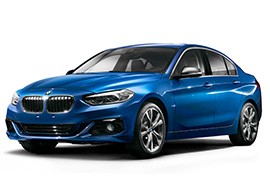BMW 1 Series Sedan Models/Series Timeline, Specifications & Photos
First production year: 2017
Engines: Gasoline
While Europe and the North American continents got the 1 Series only as hatchbacks, the German automaker created a four-door sedan version exclusively for the Chinese market in 2017.
BMW sold more than half a million cars in China in 2016, and its customers were keen to get a lower-priced, smaller-sized four-door sedan than the 3 Series. The quickest answer to their demands was the 1 Series Sedan, developed and produced exclusively for that market. The most significant challenge was to create a sedan that wouldn’t look like a make-up model but a thoroughly developed one. As expected, the German automaker didn’t cut corners. It didn’t even share its platform with the rest of the 1 Series, and it was front-wheel drive. Moreover, it was produced with a transversely mounted engine up front, which previously was unthinkable for any four-door Bimmer. And yet, times have changed, and the automaker had to adapt, and it did that in style. The Chinese 1 Series Sedan shared its UKL2 platform with the 2 Series Active Tourer, which was introduced by the automaker in 2014, and both models had the exact same wheelbase.
At the front, the new model came with a look that vaguely resembled the one from the 1 Series hatchback. Its swept-back headlights flanked the broad kidney grille. On the apron, BMW installed a broad reversed trapezoidal air intake flanked by a pair of scoops that housed the fog lamps. Since the car had a transverse engine layout, the hood didn’t sit as low as on the 3- or 5-door 1 Series hatchback but still retained the longitudinal lines on it.
Even though the German automaker was not a highly experienced front wheel drive car manufacturer, it had its basic rulebook about how a vehicle should look. As a result, from its profile, the 2017 BMW 1 Series Sedan revealed its short overhangs, similar to most of its RWD brothers. Furthermore, the unusually long wheelbase for such a short vehicle and the pushed-back greenhouse left the impression of a car with a classic drivetrain layout. To further emphasize this, BMW created sculptured doors with ascending lines and a short deck behind the sloped-down rear window. The rear fascia boasted a set of oversized taillights extended from the quarter panels onto the trunk’s lid and designed with horizontal lines to make the 1 Series sedan look wider.
One of the benefits of this FWD Bimmer was the interior room. Customers were greeted with the same quality of materials and overall design as any other BMW 1 Series. There was also a significant difference. Since the hood sat higher, the seats had to be mounted in a slightly elevated position compared to the 1 Series hatchback (F20). The rounded instrument cluster that fronted the driver featured the exact same dials for the speedometer and tachometer as its European stablemates, but it still lacked information about the engine temperature. Only the fuel level gauge was permanently shown. For anything else, drivers had to access the car’s onboard computer. The German automaker didn’t cheap out with options and amenities and provided the 2017 BMW 1 Series sedan with a standard infotainment system featuring a display placed atop the center stack. In the back, since it didn’t have a transmission tunnel anymore, the knee room was generous and allowed three passengers to sit on the bench seat.
Under the hood, BMW installed a choice of three turbocharged gasoline powerplants with three or four cylinders. They were all part of the B-engine family and were paired as standard with Aisin automatic transmissions. The most significant difference was that the base version had six gears while the other two boasted eight.
